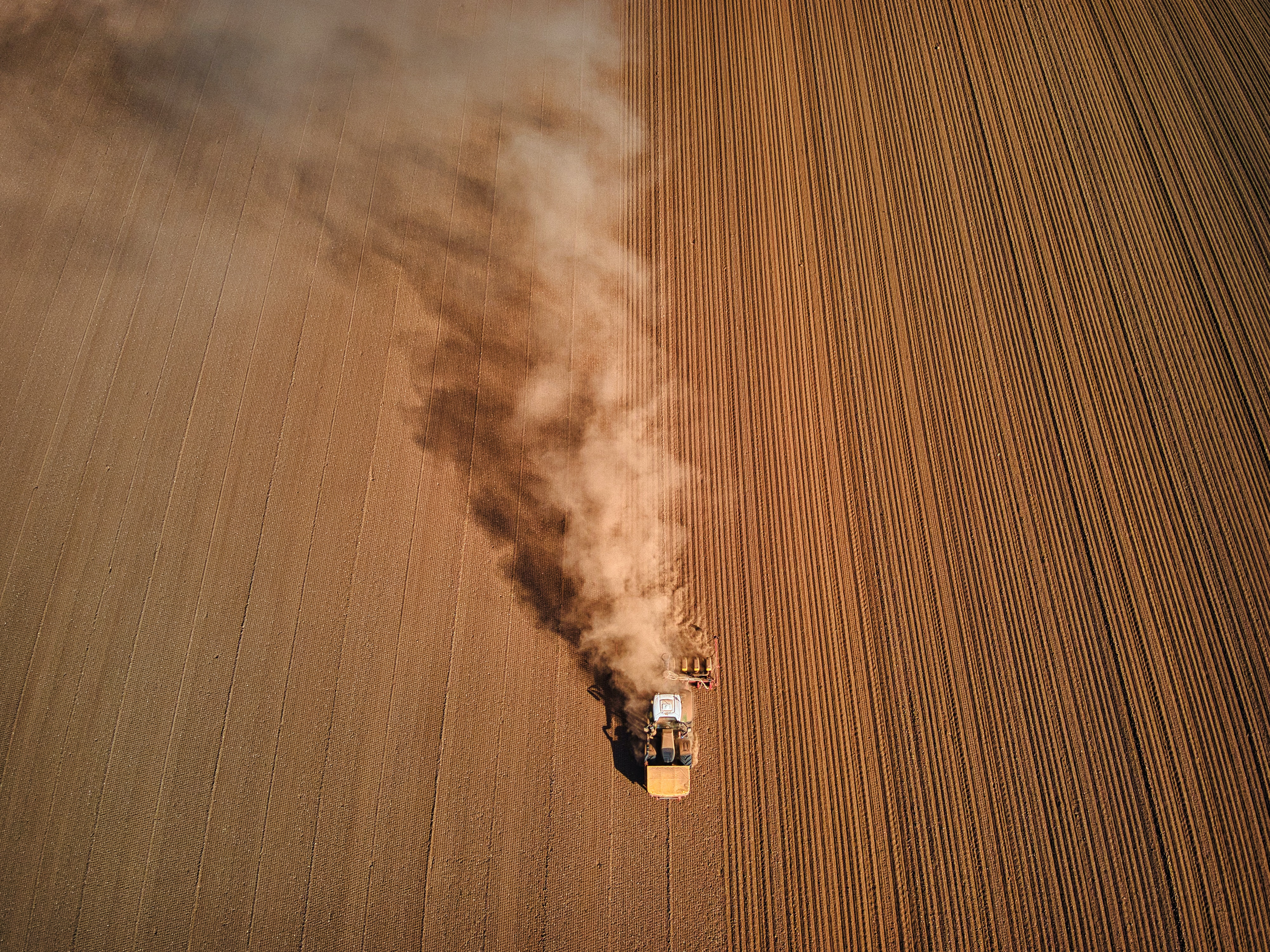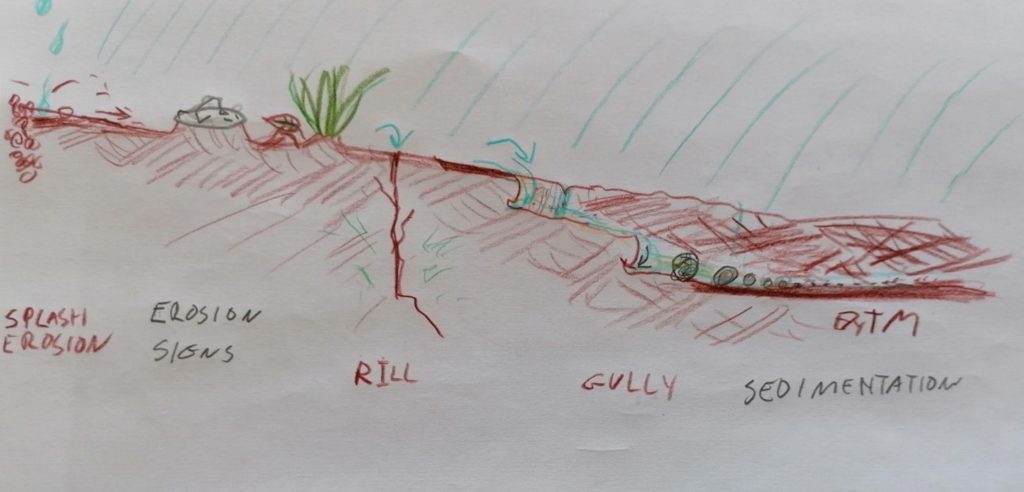Causes and Effects of Soil Erosion and rapid Water Run-off

This post is also available in:
This post is also available in:
![]() Français (French)
Français (French) ![]() Deutsch (German)
Deutsch (German) ![]() हिन्दी (Hindi)
हिन्दी (Hindi) ![]() العربية (Arabic)
العربية (Arabic) ![]() Türkçe (Turkish)
Türkçe (Turkish) ![]() 简体中文 (Chinese (Simplified))
简体中文 (Chinese (Simplified)) ![]() Português (Portuguese (Brazil))
Português (Portuguese (Brazil))
Understand practically important principles and signs of soil degradation and erosion by Torsten Mandal, agronomist
Causes of soil erosion. Bare loose soil can easily be eroded by wind or water – particularly if it is high in silt – the texture size between sand and clay and low in organic matter, and if it is powdered frequently by some forms of harrowing or other tillage.
Soil and water conservation can improve soil fertility and water management.
Soil and water conservation is essential for sustainable, resilient, cost-effective, and productive farming. Many soil fertility benefits take time to be obtained. Soil conservation can also help quickly with water management. Farmers may often be more interested in urgent problems of drought and floods related to erosion and not give priority to specific advice. Usually, the topic is neglected or misunderstood – and inaction and wrong actions worsen it. Many solutions can be adjusted and serve many purposes if the farmer and advisors (agronomists) understand the relevant principles well.
When rainfalls start, most water will enter the soil during the first 5 minutes or so. Still, many people will not remain in the field and see the important part of the erosion. It suddenly starts when the soil pores are filled with water and particles if the soil is hit directly by energetic raindrops. Then erosion and run-off suddenly accelerated. Cost-effective prevention tends to receive little attention from decision-makers in cities. Attention here can require dunes to cause damage or downstream areas, hydropower dams, channels, and cities are damaged by sediments, pesticides, and nutrients. Stopping wind- or water erosion (soil removal) is in focus in the narrow sense in this chapter. That can require soil and water conservation for the broader purpose of preventing or reversing the degradation of soil fertility in the form of direct erosion, organic matter, soil structure, nutrient depletion, and/or build-up of salt. This will briefly be covered here and in more detail in the following sections.

Figure 1. From left to right. Water erosion processes and signs. Raindrops spoil soil aggregates (crumbs and clods) and soil structure sealing the soil surface and causing splash and sheet erosion after a few minutes of intense rain, particularly in silty soil low in organic matter. Soil is removed where it is not protected by stones, litter, or plants near the surface. It can form rills that can join into gullies more than about 20 cm deep and with undermining waterfalls at their heads. The coarsest particles (sand) first, the silt and finally clay when flow speed reduces.
Erosion removes first the most fertile part of the soil – the topsoil. Also, water distribution and nutrients become poor within or outside the field. See the Figure 1 above. Much erosion can suddenly occur in more places with increasingly extreme rainfalls and winds. These may include even fields with modest slopes or with mild wind speeds. Moderate wind can make particles roll or jump near the surface, and the strong wind carries them high and far. Sand can scratch the wax layer of leaves and further increase water loss due to drying wind. Raindrops splash soil longer downslope than upslope, close soil pores, and the erosion gets much faster. Sheet erosion takes place also even before more energetic flows forms rill erosion.
Forming new soil takes very long. Some soils only have shallow topsoil and very infertile soil rocks below them. Accordingly, only a soil loss of 10 tons/hectare per year is often considered tolerable (100 m x 100 m = 1 ha). That is one kg per square meter.
Identify and understand erosion types.
Early signs of erosion are the removal of unprotected, loose soil (e.g., besides stones, plants, or residues) and deposition (sedimentation) of it where soil movement is slowed or stopped. See the figure above. The dusty soil fraction between typical sand and clay is most erodible, but it is the richest in nutrients and best in holding water available for plants. This powdery fraction is called silt, fine sand, or coarse clay, and the classifications among these change between countries. The biggest particles need the highest speed to move, so deposited material will be sorted after texture (particle size). See the figure above on the right side. Clay and organic matter hold more together, but even the clay can be dispersed when wet. How particles stick together in aggregates determines the soil structure.
A simple test of soil texture composition is based on the biggest particles sinking first despite their similar densities. Typical clay clods can be dispersed in water e.g., 30 minutes, and then stirring the soil well in transparent glasses with much more water than soil will show sand at the bottom, silt above it, clay higher again, and some of the organic matter on top. In red and yellow tropical soils, “clay” particles can stick so hard together that they may be classified as “sand” or “silt”, and soil laboratories will add a chemical to disperse more than in pure water. Therefore, soaking and stirring times matter.
It also can be used to understand soil fertility variation within many fields. . This is because the biggest particles will settle first (but their densities are similar). Tropical clay particles often stick so hard together that they practically are sand or silt, so the soaking and stirring (or e.g. adding salt) can make a difference for the test. The most infertile parts of a field have often been eroded the most (unless the retention of too much water is the cause of the problem).
Later, wind erosion can form small or big dunes. The dunes may move if they and the landscape are not protected with enough vegetation to reduce wind speeds and build up organic matter. It is usually in windy areas without high rainfall and silty or fine sand soil.
Water erosion can evolve from sheet to rill erosion, where water speed (kinetic energy) and erosion get much faster. If rills are too big to cover with normal tillage, they form gully erosion. Gullies without vegetation can accelerate quickly from the sides, bottom, and waterfall, undermining the gully head.
River and coastal erosion can occur, too, and rapid run-off from the field can increase river erosion. Sediments can cause many problems in channels, dams, rivers, lakes, coast, etc. Particularly if the sediments are high in nutrients, limiting the growth of algae (usually Nitrogen or Phosphorus), or have high levels of pesticides.
Landslides can suddenly occur after heavy rains, melting of snow, or storms on slopes with wind-exposed tall, heavy trees, not sheltered inside a forest. It can occur on steep slopes. It can also happen on some old soils (e.g., Luvisols or Alfisols) with only a few percent slopes like 2-5%, where the clay has been washed down into the soil, forming a clay pan. This subsoil layer can easily be compacted by tractor traffic when it is too moist. Then roots and rains cannot penetrate well, and the whole topsoil suddenly can slide down the slope. Small segments to hold the water are not enough. Continuous, deep ditches cut for soil conservation across the slope can also cause landslides.
Land degradation can gradually make the soil more exposed to erosion by wind or water run-off and cause other types of land degradation. It can happen with “intensive” and “extensive” agriculture and land use.
References
Baumhardt RL, and Blanco-Canqui H 2014 Soil: Conservation Practices. In: Neal Van Alfen, editor-in-chief. Encyclopedia of Agriculture and Food Systems 5, Elsevier, 153-165.
Hudson W N 1987 Soil and water conservation in semi-arid areas. Silsoe Associates Ampthill, Bedford United Kingdom. Soil Resources, Management and Conservation Service. FAO Land and Water Development Division. Food and Agriculture Organization of the United Nations Rome, 1987 https://www.fao.org/3/t0321e/t0321e00.htm
Land and Water Division 2000 Manual on Integrated Soil Management and Conservation Practices. FAO land and water bulletin Series number: 1024-6703. 214 pp. ISBN: 9251044171 https://www.fao.org/publications/card/en/c/31f117c4-13e2-5631-bf16-ebaaa10b714f
Muriuki JP, Macharia PN 2011 Green Water Credits Report K12: Inventory and Analysis of Existing Soil and Water Conservation Practices in Upper Tana, Kenya. https://www.isric.org/documents/document-type/green-water-credits-report-k12-inventory-and-analysis-existing-soil-and Open access.
Mandal T. 2010. Low-cost soil and water conservation with many early benefits. Presentation Researchers’ Day: Climate Change Impact, Adaptation and Mitigation GEUS, Inst. of Geography, University of Copenhagen. 7 October 2010. Arranged by the Climate Change Task Force. https://www.yumpu.com/en/document/view/35209735/present-danish-water-forum
Thomas DB et al. 1997. Soil and water conservation manual. Soil and Water Conservation Branch, Min. Agric. Livestock Dev. and Marketing, Nairobi Kenya.
Watene G and others 2021 Water Erosion Risk Assessment in the Kenya Great Rift Valley Region Sustainability 2021, 13(2), 844; https://doi.org/10.3390/su13020844









































































